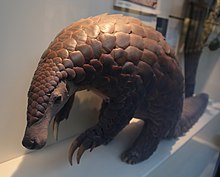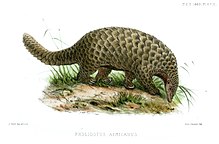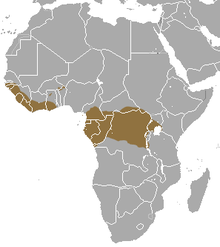Giant pangolin
| Giant pangolin | |
|---|---|

| |
| Mounted specimen in the Natural History Museum, London | |

| |
| Illustration by Joseph Wolf | |
| Scientific classification | |
| Domain: | Eukaryota |
| Kingdom: | Animalia |
| Phylum: | Chordata |
| Class: | Mammalia |
| Order: | Pholidota |
| Family: | Manidae |
| Genus: | Smutsia |
| Species: | S. gigantea
|
| Binomial name | |
| Smutsia gigantea | |

| |
range
| |
| Synonyms | |
The giant pangolin (Smutsia gigantea) is a species of pangolins from genus Smutsia of subfamily Smutsiinae within the family Manidae. It is the largest living species of pangolins.[7][8][9] Members of the species inhabit Africa with a range stretching along the equator from West Africa to Uganda. It subsists almost entirely on ants and termites.
Description[edit]
The giant pangolin is the largest of all pangolin species. While its average mass has not been measured, one specimen was found to weigh between 30 kg (66 lb) and 40 kg (88 lb).[9] Males are larger than females, with male body lengths about 137 cm (54 in) to 180 cm (71 in) and females about 112.5 cm (44.3 in) to 136.5 cm (53.7 in).[9] Like all pangolins, the species is armored with large, brown to reddish-brown scales formed from keratin. Curiously, it also has eyelashes. The giant pangolin has a long snout, a long, thick tail, and large front claws.
The animal has a strong sense of smell and large anal glands. Its secretions may be significant to animal communication. The species walks with most of its weight on its columnar rear legs, and curls its front paws, walking on the outside of the wrists rather than the palms to protect the claws. Unlike its close relative, the ground pangolin, this pangolin does not walk upright as a biped.[9]
Distribution and habitat[edit]
The giant pangolin inhabits many countries, with the largest concentration in Uganda, Tanzania. It is found mainly in the savanna, rainforest, and forest, inhabiting areas with large termite populations and available water. It does not inhabit high-altitude areas.[citation needed] A small number of recorded sightings have occurred in western Kenya within the East African montane forests, the first being reported in 1971, with subsequent sightings being made in 2018. One of these sightings took place at 2,466 metres (8,091 ft) above sea level, the highest altitude the species has been recorded at.[10]
Behavior and ecology[edit]
The giant pangolin, like other pangolins, is nocturnal, which makes observation difficult. It is also usually solitary, although in one case an adult was seen in a burrow with a juvenile.
Diet[edit]
Like all pangolins, the giant pangolin is a specialized insectivore that lacks teeth and the ability to chew. Its diet mainly consists of ants and termites, which it finds by tearing open anthills and termite nests, both subterranean and mound-type.
Because of its relatively large size, the giant pangolin is particularly well-suited to breaking open termite mounds by leaning on the mound and resting its weight on its tail, and then ripping into the mound with its front claws. The combination of weight and physical damage quickly leads to a partial collapse of the mound, exposing the termites. Only the adults are strong enough to do this; their young must follow behind their mothers until they grow large enough to do it for themselves. It eats the insects by picking them up with its sticky tongue, which is up to 70 cm (28 in) long fully extended and can extend out of the mouth for more than 30 cm (12 in).[9]
Reproduction[edit]
Very little information about the reproduction of the giant pangolin is known. Two birth records exist, with one litter in September and another in October, with the young weighing around 500 g (18 oz). As in all pangolins, infants have soft scales that eventually harden, and are born with open eyes. They cannot walk on their legs, but can move on their bellies. During age 6–8 weeks, the young often spew a yellow secretion from their anal glands (that is often said to smell of decay and cabbage) to keep predators and other animals from taking advantage of their mothers.
Threats[edit]
The giant pangolin is threatened by habitat destruction and deforestation, and hunting for the bushmeat trade.[2] Between 2011 and 2015, nine shipments with pangolin body parts were seized in Asia that originated in Nigeria. They contained 3,000 kg (6,600 lb) pangolin meat and close to 5,500 kg (12,100 lb) pangolin scales that were destined to China and Laos.[11]
Conservation[edit]
The giant pangolin has been listed on CITES Appendix I since January 2017.[2]

Phylogeny[edit]
Phylogenetic position of Smutsia gigantea within family Manidae[12][13][14][15]
| Pholidotamorpha |
| ||||||||||||||||||||||||||||||||||||||||||||||||||||
(Pholidota sensu lato)
|
See also[edit]
References[edit]
- ^ Timothy J. Gaudin (2010.) "Pholidota". In Lars Werdelin and William Joseph Sanders (eds.) "Cenozoic Mammals of Africa". University of California Press, Berkeley, London, New York, pp. 599-602
- ^ a b c d Nixon, S.; Pietersen, D.; Challender, D.; Hoffmann, M.; Godwill Ichu, I.; Bruce, T.; Ingram, D. J.; Matthews, N. & Shirley, M. H. (2019). "Smutsia gigantea". IUCN Red List of Threatened Species. 2019: e.T12762A123584478. doi:10.2305/IUCN.UK.2019-3.RLTS.T12762A123584478.en. Retrieved 17 January 2022.
- ^ Illiger, C. (1815). "Überblick der Säugethiere nach ihrer Verteilung über die Welttheile". Abhandlungen der Königlichen Preußischen Akademie der Wissenschaften zu Berlin. 1804−1811: 39−159. Archived from the original on 2019-06-08. Retrieved 2023-06-04.
- ^ Fitzinger, L. J. (1872.) "Die naturliche familie der schuppenthiere (Manes)." Sitzungsberichte der Kaiserlichen Akademie der Wissenschaften. Mathematisch-Naturwissenschaftliche Classe, CI., LXV, Abth. I, 9-83.
- ^ Grubb, P., Jones, T. S., Davies, A. G., Edberg, E., Starin, E. D., Hill, J. E. (1998.) "Mammals of Ghana, Sierra Leone and the Gambia." Trendrine Press, Zennor, Cornwall.
- ^ Gray, J. E. (1865). "Revision of the genera and species of entomophagous Edentata, founded on the examination of the specimens in the British Museum". Proceedings Zoological Society: 359–386.
- ^ Schlitter, D.A. (2005). "Order Pholidota". In Wilson, D.E.; Reeder, D.M (eds.). Mammal Species of the World: A Taxonomic and Geographic Reference (3rd ed.). Johns Hopkins University Press. p. 530. ISBN 978-0-8018-8221-0. OCLC 62265494.
- ^ Gaudin, Timothy (2009). "The Phylogeny of Living and Extinct Pangolins (Mammalia, Pholidota) and Associated Taxa: A Morphology Based Analysis" (PDF). Journal of Mammalian Evolution. 16 (4): 235–305. doi:10.1007/s10914-009-9119-9. S2CID 1773698. Archived from the original (PDF) on 25 September 2015. Retrieved 14 May 2015.
- ^ a b c d e Michael Hoffmann, Stuart Nixon, Daniel Alempijevic, Sam Ayebare, Tom Bruce, Tim R. B. Davenport, John Hart, Terese Hart, Martin Hega, Fiona Maisels, David Mills, Constant Ndjassi (2020), Challender, Daniel W. S.; Nash, Helen C.; Waterman, Carly (eds.), "Chapter 10 - Giant pangolin Smutsia gigantea (Illiger, 1815)", Pangolins, Biodiversity of World: Conservation from Genes to Landscapes, Academic Press, pp. 157–173, doi:10.1016/B978-0-12-815507-3.00010-1
{{citation}}: CS1 maint: multiple names: authors list (link) - ^ Sandri, Tommy; Okell, Claire; Nixon, Stuart; Matthews, Naomi; Omengo, Fred; Mathenge, James; Ndambuki, Stephen; Challender, Daniel W.S.; Chepkwony, Richard; Omondi, Patrick; Ngene, Shadrack; Cain, Bradley (4 July 2022). "Three spatially separate records confirm the presence of and provide a range extension for the giant pangolin Smutsia gigantea;; in Kenya". Oryx. Short Communication: 1–4. doi:10.1017/S0030605322000126.
- ^ Gomez, L.; Leupen, B. T. C. & Hwa, T. K. (2016). "The trade of African pangolins to Asia: a brief case study of pangolin shipments from Nigeria" (PDF). Traffic Bulletin. 28 (1).
- ^ Gaudin, Timothy (2009). "The Phylogeny of Living and Extinct Pangolins (Mammalia, Pholidota) and Associated Taxa: A Morphology Based Analysis" (PDF). Journal of Mammalian Evolution. 16 (4). Heidelberg, Germany: Springer Science+Business Media: 235–305. doi:10.1007/s10914-009-9119-9. S2CID 1773698. Archived from the original (PDF) on 2015-09-25. Retrieved 2015-05-14.
- ^ Kondrashov, Peter; Agadjanian, Alexandre K. (2012). "A nearly complete skeleton of Ernanodon (Mammalia, Palaeanodonta) from Mongolia: morphofunctional analysis". Journal of Vertebrate Paleontology. 32 (5): 983–1001. doi:10.1080/02724634.2012.694319. ISSN 0272-4634. S2CID 86059673.
- ^ Philippe Gaubert, Agostinho Antunes, Hao Meng, Lin Miao, Stéphane Peigné, Fabienne Justy, Flobert Njiokou, Sylvain Dufour, Emmanuel Danquah, Jayanthi Alahakoon, Erik Verheyen, William T Stanley, Stephen J O’Brien, Warren E Johnson, Shu-Jin Luo (2018) "The Complete Phylogeny of Pangolins: Scaling Up Resources for the Molecular Tracing of the Most Trafficked Mammals on Earth" Journal of Heredity, Volume 109, Issue 4, Pages 347–359
- ^ Sean P. Heighton, Rémi Allio, Jérôme Murienne, Jordi Salmona, Hao Meng, Céline Scornavacca, Armanda D. S. Bastos, Flobert Njiokou, Darren W. Pietersen, Marie-Ka Tilak, Shu-Jin Luo, Frédéric Delsuc, Philippe Gaubert (2023.) "Pangolin genomes offer key insights and resources for the world’s most trafficked wild mammals"
External links[edit]
- Ciszek, D. (1999). "Manis gigantea". Animal Diversity Web, University of Michigan Museum of Zoology.
- IUCN Red List endangered species
- Smutsia
- Myrmecophagous mammals
- Fauna of Central Africa
- Mammals of West Africa
- Mammals described in 1815
- Species endangered by habitat loss
- Species endangered by deforestation
- Species endangered by human consumption
- Species endangered by human consumption for medicinal or magical purposes

